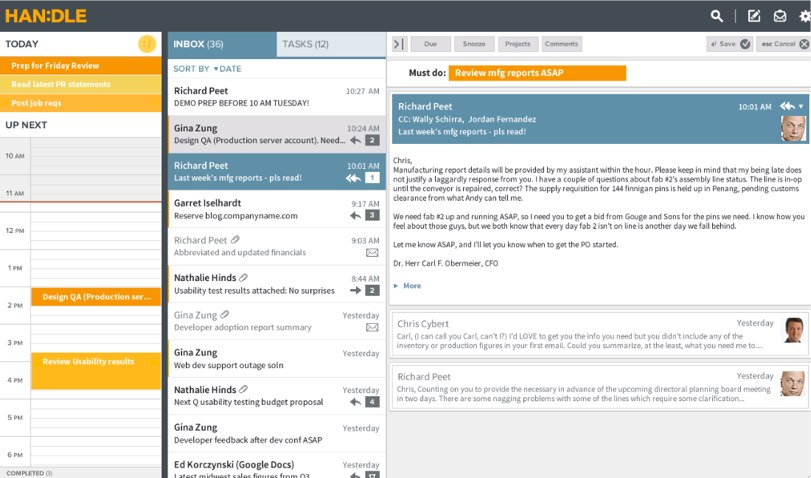College recruiting is becoming increasingly competitive. Companies have begun to realize that top graduates not only bring a lot of talent and energy to the table, but they also tend to cost less than more experienced prospects. But in order to successfully woo those fortunate enough to have their pick, businesses need to begin the recruiting process earlier. If they're going to stand a chance, they have to build long-term, non-spammy relationships with students and educate them on the opportunities and culture unique to their business.
This is especially true for startups and SMBs, which usually lack the campus mindshare (and budget) of the Googles and Facebooks of the world. University of Michigan and UPenn alums Azarias Reda and Lander Garcia are launching Meritful at TechCrunch Disrupt NY today to provide startups and SMBs with a solution to this recruiting problem.
Essentially, Meritful aims to help the little guys start winning the Talent Wars by enabling them to build long-term relationships with top grads. To follow through on this mission, the Michigan-based startup wants to address two unique features of college recruiting.
First, when companies visit campuses for career fairs and information sessions, they meet a lot of students. Second, those prospects remain in the pipeline for a number of years before they are actually ready to apply for a job. To solve these two problems, Meritful is building a student-centric CRM platform that helps recruiting teams build and mange their relationships with students over time, starting early in their careers.
In an effort to create a simple, one-to-many method to engage students, the platform allows recruiters to invite their best student prospects to connect with current employees or alumni of the company. For example, a company can create challenges for students to work on, providing a way to directly test students for certain aptitudes or skills.
On the flip side, the platform lets students showcase projects they are working on using multimedia displays, or ask pertinent questions to alumni from their school or those who've worked in their prospective, future role. This allows companies to use their best ambassadors, their employees, to show off who they are, how they're different and help them find students who are the right fit.
As to how it works: When a company signs up on Meritful, recruiting teams are asked to choose some of the employees at the company to become ambassadors and invite them to the platform. These ambassadors can be other recruiters, engineers or alumni. When companies meet promising students at career fairs or through their student career pages, they invite prospective students to connect with them on Meritful.
Once connected, companies can then interact with students and keep tabs on the projects they're working on, their challenges, successes and so on. They can also create challenges for students to work on, which could be programming, design, business or research-related, to which students can submit solutions, while interacting with ambassadors in the process. The idea is for this to become another way for recruiters to find the best talent, and the right match.
Similar to portfolio platforms like Pathbrite, students can showcase projects they're working on — in or outside of class — and ask for feedback from ambassadors. They can use source code, pictures or video to describe the projects, giving companies a fuller picture of their academic and professional abilities. Recruiters can also engage students through Q&As and share content and, over time, can keep track of their progress, projects and completed challenges, for example.
Prior to launching at Disrupt, Meritful spent six months in private beta, working with companies like Twilio and Cengage learning. Going forward, co-founders Reda (who previously worked at LinkedIn) and Lander Coronado-Garcia (ex-Accenture) say that they'll be looking to build out its roster of companies and build out its student engagement tools.
Meritful recently won a startup competition at SXSW, taking home $100K in prizes, and will be looking to begin raising its seed round this summer.
Q&A
Megan Quinn: Will you use this for internships?
A: One of the pools of students we want to engage with, want to help them build relationships with students from the beginning so they don't necessarily have to be interns.
Hilary Mason: What kind of tracking and data collection will you include?
A: Tracking how long a student stays at a company, how well that company retains their talent, ongoing recruiting is definitely part of the plan.
John Frankel: What's the breakdown of internships to full-time hires?
A: Either way you slice it, the key to Meritful is matching the best talent to the right company. We want companies to use this for internships, but also want it to breed full-time hires as well to build value for the company over the long-run.



































 Valentine's gets a brief mention in the midst of chocolate, watches and shoes in our weekly showcase of The Dachis Group's Social Business Index.
Valentine's gets a brief mention in the midst of chocolate, watches and shoes in our weekly showcase of The Dachis Group's Social Business Index.
 The Swatch Group isn't hiding anything this week as it continues to ramp up efforts across the globe to promote its "True love has nothing to hide" Valentine's Day campaign (and exclusive heart watch to match). And Swatch is truly global in its efforts -- in countries where the love holiday isn't celebrated (
The Swatch Group isn't hiding anything this week as it continues to ramp up efforts across the globe to promote its "True love has nothing to hide" Valentine's Day campaign (and exclusive heart watch to match). And Swatch is truly global in its efforts -- in countries where the love holiday isn't celebrated ( 'Michael Jordan Mondays' is Foot Locker's big weekly Facebook post. Celebrity partnerships are a known quantity in big brand social programs: they just work. In this case, Foot Locker's social performance was boosted up because of MJ related posts. These have consistently produced upwards of 30,000 likes throughout the series of promotions.
'Michael Jordan Mondays' is Foot Locker's big weekly Facebook post. Celebrity partnerships are a known quantity in big brand social programs: they just work. In this case, Foot Locker's social performance was boosted up because of MJ related posts. These have consistently produced upwards of 30,000 likes throughout the series of promotions.  Mondays are hard for all of us. Yet Ferrero International, the Italian chocolate manufacturer, managed to make the day a little less dismal with a Facebook post improving the start of the workweek. By combining positive reinforcement (being able to eat Nutella) with waking up, Nutella made 6,790 people get out of bed or at least post on Facebook.
Mondays are hard for all of us. Yet Ferrero International, the Italian chocolate manufacturer, managed to make the day a little less dismal with a Facebook post improving the start of the workweek. By combining positive reinforcement (being able to eat Nutella) with waking up, Nutella made 6,790 people get out of bed or at least post on Facebook. 
 As the month of December progresses, consumers become more immersed in the spirit of the season. At Betty Crocker, its no different, where seasonal posts consistently dominate the social content of the General Mills' subsidiary. Holiday food posts featuring the home baked goods of Mrs. Betty Crocker fill loyal fans with winter glee. One delectable photo showed off the iconic woman's skill at transforming cupcakes into faux hot chocolate. These chocolate
As the month of December progresses, consumers become more immersed in the spirit of the season. At Betty Crocker, its no different, where seasonal posts consistently dominate the social content of the General Mills' subsidiary. Holiday food posts featuring the home baked goods of Mrs. Betty Crocker fill loyal fans with winter glee. One delectable photo showed off the iconic woman's skill at transforming cupcakes into faux hot chocolate. These chocolate  Kia Motors' Worldwide Facebook page's most popular post last week was a pinned
Kia Motors' Worldwide Facebook page's most popular post last week was a pinned 

